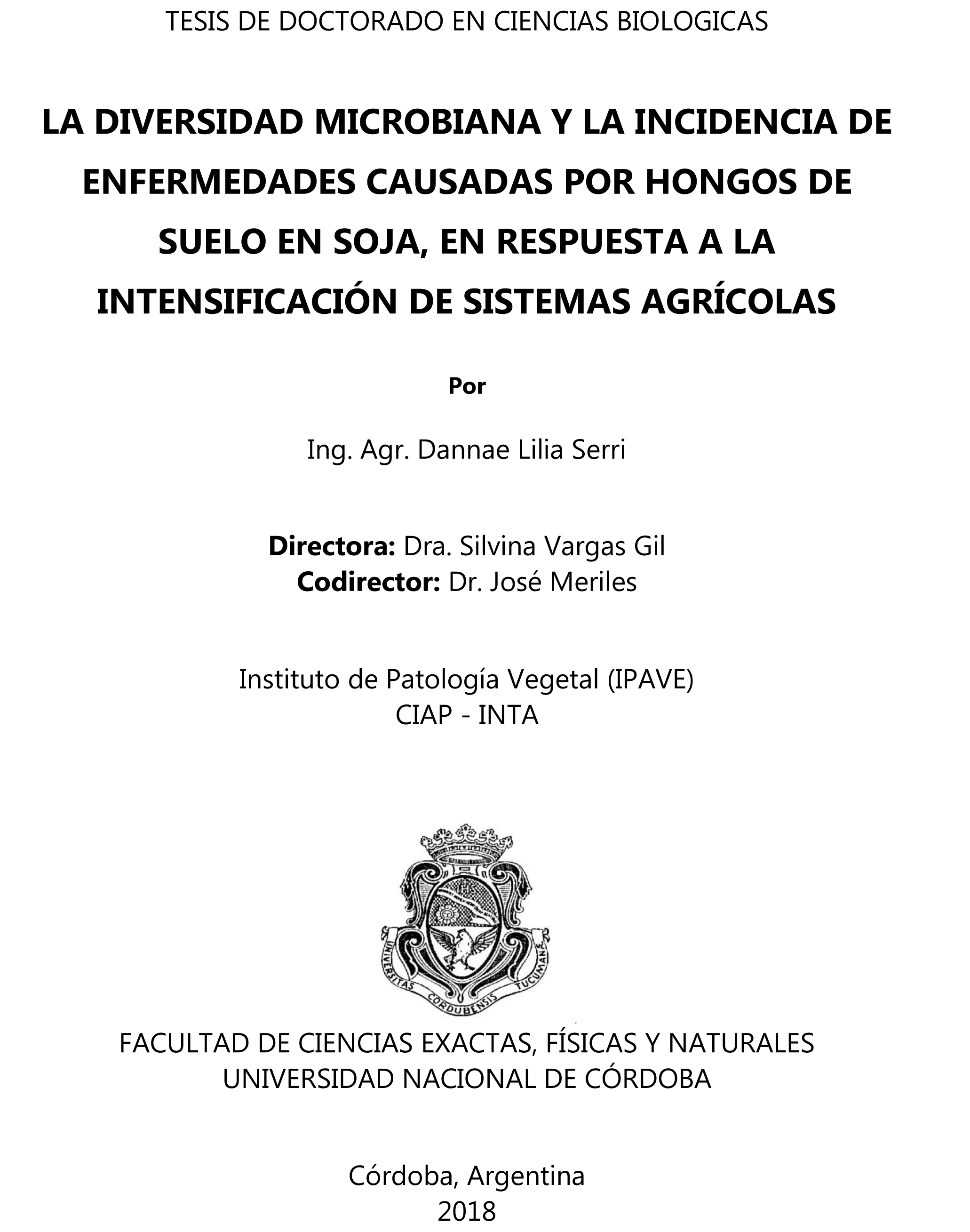Ver ítem
- xmlui.general.dspace_homeCentros e Institutos de InvestigaciónCIAP. Centro de Investigaciones AgropecuariasInstituto de Patología VegetalTesisxmlui.ArtifactBrowser.ItemViewer.trail
- Inicio
- Centros e Institutos de Investigación
- CIAP. Centro de Investigaciones Agropecuarias
- Instituto de Patología Vegetal
- Tesis
- Ver ítem
La Diversidad Microbiana y la Incidencia de enfermedades causadas por hongos de suelo en soja, en respuesta a la intensificación de sistemas agrícolas
Resumen
En las últimas décadas, los sistemas agrícolas de la pampa húmeda experimentaron un proceso de simplificación de las rotaciones, con predominio de soja en monocultivo y largos períodos de barbecho otoño-invernal, causando la degradación del suelo y disminuyendo su biodiversidad. En consecuencia, las comunidades microbianas del suelo sufren cambios en su estructura, y se alteran las funciones y procesos biológicos en los que están involucradas. Como
[ver mas...]
En las últimas décadas, los sistemas agrícolas de la pampa húmeda experimentaron un proceso de simplificación de las rotaciones, con predominio de soja en monocultivo y largos períodos de barbecho otoño-invernal, causando la degradación del suelo y disminuyendo su biodiversidad. En consecuencia, las comunidades microbianas del suelo sufren cambios en su estructura, y se alteran las funciones y procesos biológicos en los que están involucradas. Como resultado, se ha incrementado la incidencia de enfermedades causadas por hongos de suelo en el cultivo de soja. Para contrarrestar estos efectos, una estrategia de manejo promisoria es la intensificación sustentable de los sistemas agrícolas, mediante la rotación de cultivos y el uso de cultivos de cobertura invernal. Esta diversificación del estrato superficial crea condiciones que favorecen el incremento de la diversidad de las comunidades microbianas de suelo, que determinan la capacidad de recuperación del sistema edáfico, aportando efectos benéficos a las plantas, al suelo y al ecosistema.
[Cerrar]
In the last decades, the agricultural systems of the humid Pampas underwent a process of simplification of the crop rotation, with predominance of soybean in
monoculture and long periods of autumn-winter fallow, causing the degradation of the soil and diminishing its biodiversity. Consequently, the microbial communities of the soil undergo changes in their structure, functions and in the biological processes in which they are involved. As a result, the
[ver mas...]
In the last decades, the agricultural systems of the humid Pampas underwent a process of simplification of the crop rotation, with predominance of soybean in
monoculture and long periods of autumn-winter fallow, causing the degradation of the soil and diminishing its biodiversity. Consequently, the microbial communities of the soil undergo changes in their structure, functions and in the biological processes in which they are involved. As a result, the incidence of diseases caused by soil fungi in soybean has increased. To counteract these effects, a promising management strategy is the sustainable intensification of agricultural systems, through the rotation of crops and the use of winter cover crops. This diversification of the surface layer creates conditions that favor the increase of the diversity of soil microbial communities, which determine the recovery capacity of the edaphic system, contributing beneficial effects to plants, soil and ecosystem.
The objective of the study was to identify the level of sustainable intensification of an agroecosystem that contributes to increase soil microbial diversity, in relation with the associated chemical and physical variables and soybean productivity, counteracting the incidence of diseases caused by soilborne fungi. The research work was carried out in a long-term trial, belonging to the INTA Oliveros Experimental Agricultural Station, Santa Fe. The treatments resulted from the combination of soybean (S), corn (M) and wheat (T) crops and the inclusion of a winter cover crop (CC), being: SS; CC-S; M-S-T/S; M-CC-S-T/S; M-T/S and M-T/SCC. The soil sampling was carried out during three consecutive seasons, during the period of manifestation of the Sudden Death Syndrome (SDS). The microbial diversity of the soil was quantified by the determination of structure of the community and its functions, along with chemical and physical edaphic parameters, the incidence of SDS and soybean yield. The structure of the microbial
community allowed the differentiation of the sequences under rotation and inclusion of the CC compared with S-S (monoculture), mainly explained by increases in total microbial biomass. Considering microbial functions, the most diversified crop sequences positively influenced the increase in enzymatic activity of fluorescein diacetate and acid phosphatase, and the decrease in the metabolic
coefficient. In addition, chemical parameters such as total organic carbon content, nitrates and electrical conductivity, together with physical parameters as basic infiltration were increased for the sequences with greater agricultural diversification, which in turn showed a marked edaphic acidification. About SDS, an increase in the incidence and intensity of the disease was observed for the sequences including CC, mainly CC-S and M-CC-S-T/S, accompanied by lower levels of crop productivity. In general, soil microbial diversity increased in response to sustainable intensification of agricultural systems, but failed to counteract the incidence of soybean SDS and promote crop productivity-
[Cerrar]

Autor
Director de Tesis
Meriles, José (co-director);
Descripción
Tesis para obtener el grado de Doctor en Ciencias Biológicas presentada en la Universidad Nacional de Córdoba, Facultad de Ciencias Exactas Físicas y Naturales, en diciembre 2018
Fecha
2018-12-04
Editorial
Edición de Autor
Formato
pdf
Tipo de documento
tesis doctoral
Palabras Claves
Derechos de acceso
Abierto
 Excepto donde se diga explicitamente, este item se publica bajo la siguiente descripción: Creative Commons Attribution-NonCommercial-ShareAlike 2.5 Unported (CC BY-NC-SA 2.5)
Excepto donde se diga explicitamente, este item se publica bajo la siguiente descripción: Creative Commons Attribution-NonCommercial-ShareAlike 2.5 Unported (CC BY-NC-SA 2.5)


